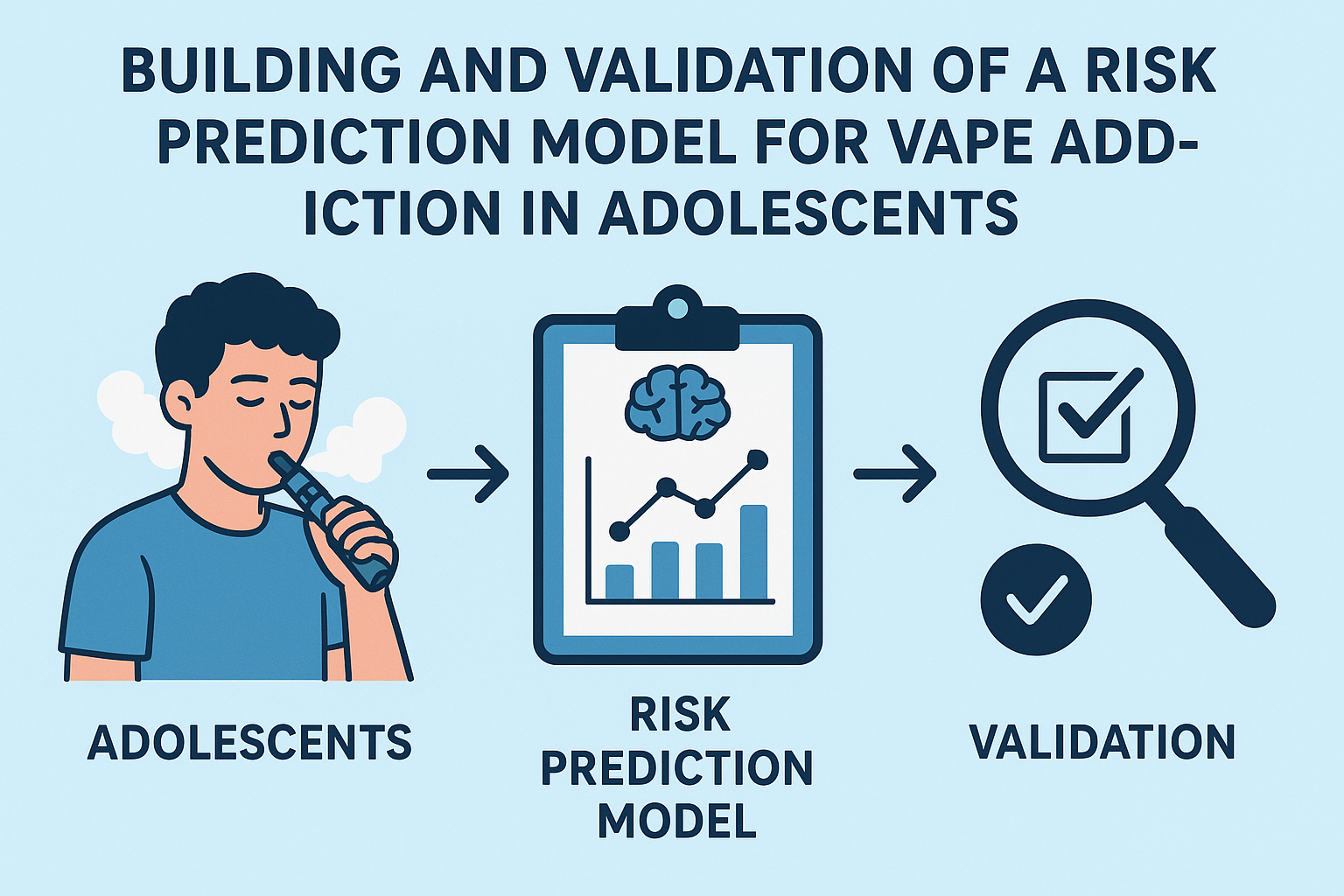
ARE YOU OF LEGAL VAPE AGE?
Please confirm that you are of legal age to purchase vaping products to access our site.

Please confirm that you are of legal age to purchase vaping products to access our site.
Some items are no longer available. Your cart has been updated.
This discount code cannot be used in conjunction with other promotional or discounted offer.
1.Abstract
2.Introduction
3.Materials and Methods
Results
Discussion
Objective: To explore the risk factors associated with Vape addiction among adolescents who useVapes and to construct and validate a predictive model for this risk.

Methods: A retrospective analysis was conducted on data from 130 adolescents who used Vapes and received treatment at the hospital between February 2021 and January 2023. The cohort was divided into a modeling set (n=91) and a validation set (n=39) in a 7:3 ratio. Participants were further categorized into an addiction group and a non-addiction group based on the presence of Vape addiction. Relevant data were collected, and univariate and multivariate logistic regression analyses were used to identify independent risk factors for Vape addiction in these adolescents. The model was visualized using a nomogram created with R software. Model consistency was evaluated using calibration curves, clinical utility was assessed via receiver operating characteristic (ROC) curves, and goodness-of-fit was determined with the Hosmer-Lemeshow (H-L) test.
Results: In the modeling set of 91 adolescents using Vapes, 38 cases were positive for Vape addiction, yielding an addiction rate of 41.76%. Multivariate analysis indicated that somatic withdrawal symptoms [Minnesota Nicotine Withdrawal Scale (MNWS) score], parent-child affinity [Family Adaptability and Cohesion Evaluation Scale II-Chinese Version (FACES II-CV) score], school life satisfaction (School Connectedness Scale score), and history of prior smoking were independent risk factors for Vape addiction in adolescents (P<0.05). A risk prediction model was constructed based on these four factors. The area under the ROC curve (AUC) in the modeling set was 0.948, with a optimal cut-off value of 0.770 corresponding to a sensitivity of 0.921 and specificity of 0.849. The calibration curve closely aligned with the ideal curve, with a mean absolute error (MAE) of 0.040, indicating good consistency. The H-L goodness-of-fit test yielded χ²=13.537, P=0.095. External validation showed an AUC of 0.955, with a cut-off value of 0.748 corresponding to a sensitivity of 0.974 and specificity of 0.774.
Conclusion: Somatic withdrawal symptoms, parent-child affinity, school life satisfaction, and history of prior smoking are independent risk factors for Vape addiction in adolescents using Vapes. The risk prediction model constructed from these factors demonstrates strong clinical predictive value.
In recent years, the widespread use of Vapes has led to a series of associated diseases, emerging as a severe global public health issue. According to 2021 World Health Organization data, global Vape sales increased to $15 billion between 2014 and 2019, projected to exceed $58 billion by 2026. The "2021 Vape Industry Blue Book" indicates that China's Vape market is growing rapidly, with a year-over-year increase of approximately 36% compared to 2020. China has over 300 million smokers, the highest number worldwide, with most smoking habits forming during adolescence. Surveys from 2017-2018 show that about 4% of Vape consumers are students. The toxicological dose of Vapes may not be lower than that of traditional cigarettes, with health risks from Vape aerosols including excessive heavy metals leading to carcinogenesis, cardiovascular adverse events, accelerated atherosclerosis, and pulmonary toxicity (due to oxidative stress, inflammation, and DNA damage). Substance addiction can alter brain structures (e.g., prefrontal cortex) and functions (desensitization and sensitization responses), a well-established fact. Adolescents, whose brains are still developing, are more sensitive to nicotine's activation of reward circuits, lacking self-control, driven by curiosity toward novel items, and influenced by peers, making them prone to Vape abuse and addiction. The "Healthy China 2030" blueprint sets a goal to reduce the smoking rate among individuals aged 15 and above to 20% by 2030. Therefore, this study retrospectively analyzed data from adolescents using Vapes treated at the hospital to explore risk factors for Vape addiction, aiming to provide clinical nursing intervention evidence for the increasingly severe issue of adolescent Vape addiction.
Inclusion Criteria
Age 12-18 years; 2) Complete relevant data; 3) Currently enrolled students; 4) Vape users.
Exclusion Criteria
History of psychiatric disorders or psychotropic drug abuse; 2) Severe impairment of vital organ functions (heart, brain, kidney, etc.); 3) Addiction to substances other than nicotine (e.g., alcohol, online gaming).
Sample Size and Grouping
Based on the Harrell criterion, this study included 12 variables, requiring a sample size of 5-10 times the number of variables (60-120 cases). Accounting for 8%-10% data loss, after consultation with senior psychiatric nurses experienced in statistical analysis, data from 130 adolescents using Vape treated between February 2021 and January 2023 were selected. The cohort was divided into a modeling set (n=91) and a validation set (n=39) in a 7:3 ratio, and further grouped into addiction and non-addiction groups based on Vape addiction presence. This study was approved by the hospital's medical ethics committee.
Relevant data from enrolled adolescents were collected, including age, gender, body mass index (BMI), Vape usage patterns, educational status (mode, type), smoking history, residence, family situation (single-parent or left-behind), and questionnaire data.
Vape addiction was assessed using the Fagerström Test for Nicotine Dependence (FTND), with a Cronbach's α of 0.89. The scale totals 10 points across 6 items, with 2 items using Likert 4-level scoring and 4 using binary scoring. A score ≥4 indicates positive Vape addiction, with higher scores denoting greater nicotine dependence. Somatic withdrawal symptoms were evaluated using the Minnesota Nicotine Withdrawal Scale (MNWS), totaling 36 points across 6 items, all using Likert 5-level scoring; higher scores indicate more severe withdrawal symptoms. Parent-child affinity was assessed with the Family Adaptability and Cohesion Evaluation Scale II-Chinese Version (FACES II-CV), Cronbach's α=0.821, totaling 150 points across 30 items using Likert 6-level scoring (0 for "never" to 5 for "always"); higher scores indicate better affinity. School life satisfaction was evaluated using the School Connectedness Scale, Cronbach's α=0.879, totaling 50 points across 10 items using Likert 5-level scoring (1 for "strongly disagree" to 5 for "strongly agree"); higher scores indicate greater satisfaction.
Data were analyzed using SPSS 24.0 software. Qualitative data were expressed as counts and percentages (%), analyzed with χ² tests; quantitative data conforming to normal distribution were expressed as mean ± standard deviation, analyzed with t-tests. Nomograms and calibration plots were created using R software. ROC curves assessed the predictive efficacy of the risk model, with P<0.05 indicating statistical significance.
Analysis revealed that among 91 adolescents in the modeling set using Vape, 38 were positive for Vape addiction (addiction group, n=38; non-addiction group, n=53), with an addiction rate of 41.76%. Univariate analysis showed significant differences between groups in somatic withdrawal symptoms (MNWS score), parent-child affinity (FACES II-CV score), school life satisfaction (School Connectedness Scale score), and history of prior smoking (P<0.05).
Univariate results from Table 1 were incorporated into multivariate analysis, with Vape addiction as the dependent variable and univariate indicators as independent variables (assignments in Table 2). Logistic regression identified MNWS score, FACES II-CV score, School Connectedness Scale score, and history of prior smoking as independent risk factors for Vape addiction in adolescents (P<0.05).
Based on multivariate results, the model was constructed: Logit(P) = 6.172 - 0.213 × (MNWS score) + 0.062 × (FACES II-CV score) + 0.256 × (School Connectedness Scale score) - 2.677 × (history of prior smoking). A nomogram was created using the rms package in R software (version 4.2.1), see Figure 1. Internal validation: AUC=0.948 [95% CI (0.908, 0.988)], optimal cut-off=0.770 with sensitivity=0.921 and specificity=0.849. The calibration curve aligned closely with the ideal, MAE=0.040, indicating good consistency. H-L test: χ²=13.537, P=0.095, showing good fit and high predictive value.
The 39 cases in the validation set were input into the model. ROC showed AUC=0.955 [95% CI (0.919, 0.990)], cut-off=0.748 with sensitivity=0.974 and specificity=0.774. The calibration curve aligned closely with the ideal, MAE=0.038, indicating good consistency.
This study found an Vape addiction rate of 41.76% among adolescents, consistent with prior reports: 79% of adolescent respondents tried Vapes more than twice, and about 55% relapsed due to tolerance or somatic withdrawal. The "gateway effect" of Vapes leads non-smokers to nicotine dependence, particularly adolescents. Evidence confirms Vape aerosols contain harmful chemicals, increasing risks for digestive, respiratory, and cardiovascular diseases. Long-term use can cause irreversible brain damage in developing adolescents, impairing cognitive and emotional regulation. Thus, identifying risk factors for adolescent Vape addiction is crucial for developing coping and preventive strategies.
Results indicate severe somatic withdrawal (high MNWS score), poor parent-child affinity (low FACES II-CV score), low school life satisfaction (low School Connectedness Scale score), and history of prior smoking as risk factors (P<0.05). Nicotine's strong physical and psychological dependence, enhanced by flavored e-liquids and appealing designs, drives adolescent addiction and relapse. A randomized controlled trial by Ji et al.showed alleviating withdrawal reduces relapse in heavy nicotine dependence, aligning with our findings of higher MNWS scores in the addiction group. Family and school environments are primary for adolescents; poor family education (behavioral or psychological control) and low school belonging increase stress and addiction risk. Yin et al. linked parental control to negative parent-child relations and adolescent internet addiction. School pressure, peer Vape use, and social needs contribute to dependence. Prior smoking history heightens addiction risk post-transition to Vapes, as established nicotine dependence persists. Pharmacokinetic studies show Vapes deliver nicotine more efficiently than cigarettes, with experienced users inhaling more, elevating addiction risk under high doses.
In conclusion, somatic withdrawal symptoms, parent-child affinity, school life satisfaction, and history of prior smoking are independent risk factors for Vape addiction in adolescents using Vapes. The constructed risk prediction model offers strong clinical value. However, as a single-center retrospective study with limited sample size, it has methodological limitations and potential biases, requiring further validation in future research.

Comment